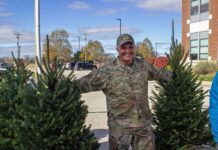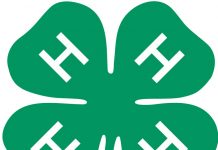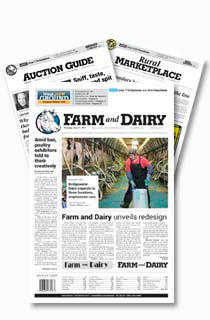
NILES, Ohio — Everyone at the Niles Senior Center is on their feet thanks to the enthusiasm of folks like Gene Hammond, a veteran square dance caller who has been involved in the scene since 1984.
“This activity is so loved by so many people,” Hammond said.
This Farm and Dairy reporter recently had the chance to learn the history and steps of the folk dance with Hammond and the Friendly Squares Dance Club during one of the group’s regular practice sessions. Interest is growing, with monthly dances especially well attended, and the group has begun offering additional classes for practice.
Hammond, who will turn 83 this December, is a longtime square dance caller, and member of Callerlab, the largest international association for square dance callers. The role of a caller, he explained, is multifaceted. It’s not just about calling the next maneuver and leading the dancers; it’s about teaching, instructing and guiding people, many of whom have never danced before.
“My job is to teach you and watch you progress through the course,” he said.
Hammond said that new dancers learn about 100 calls over the course of several months. Each call is given a specific name, and over time, dancers associate those names with the movements.
They start in a formation that resembles a square. Dancers bow to their partner, then turn their back to them and face the corner — every square has to have a corner to function — until the first call. The head couple faces the caller.
Then it goes something like this: Bow to your corner. Face the center. Where you’re at is home. All join hands. Circle left. Allemande left. Do-si-do. Heads up to the middle and back. Sides up to the middle and back. Anyone can do it.
Getting Started
Hammond’s journey to becoming a caller started somewhat unexpectedly. He was roped into his first calling experience during a benefit dance for the Heart and Cancer Society in 1984. A fellow caller convinced him to give it a shot.
“I said, ‘No, I don’t think so,’” Hammond recalled, laughing. “I couldn’t get up in front and talk to people.”
But after practicing with some vinyl records at home, and with encouragement from his wife, Hammond reluctantly agreed to call at the event. To his surprise, when his turn came to step on stage, a joke from the audience put him at ease, and the rest is history.
“There was a huge crowd, probably 1,200 people,” he said. “I guess I did OK. They said, ‘Hey, you should keep this up. Don’t quit.’ And that’s how I got started.”

In those days, square dancing was more in vogue. At one time, Hammond recalled, there were as many as six clubs in the area. Now, Friendly Squares is one of the few remaining.
Despite the downturn over the years, Hammond remains optimistic. The recent dance celebrating the club’s 14th anniversary drew a strong turnout. Hammond credits the senior center where they hold their dances and classes for providing them with a supportive space.
For Hammond, square dancing is about much more than just physical movement.
“What draws me to square dancing, and what I think brings other people, is watching people learn something they know absolutely nothing about,” he said. “To know that you have made somebody’s day just a little better, that’s worth much more than money or prestige.”
Square dancing’s motto, he said, is “friendship set to music,” a sentiment that resonates deeply with Hammond and many other dancers.
A Significant Pastime
Despite its modest existence today, square dancing has long been a favorite pastime of many important personalities. Hammond recounted how royalty, celebrities and former American presidents got their groove on.
“Ronald Reagan and Nancy … they would find time to do some square dancing,” Hammond said, noting that the president coined square dancing “America’s folk dance,” and enshrined it into law establishing its legal status with an act of Congress in 1982.
Prior to taking office, Harry Truman led a square dance club in Independence, Missouri. And Jimmy Carter said that square dancing had made his election to the presidency possible. The Georgia Democrat, in a 2011 memoir, attributed his narrow victory by 66 votes in the state senate to members of a rural square dance club he had joined in 1953. If he had lost, he wrote, he may never have run for office again.
Hammond emphasized the numerous benefits of square dancing for participants, from the physical exercise to the mental stimulation.
“It makes your brain work for you,” he said. “In later years, it’s been proven that elderly people who work crossword puzzles or do things like square dancing have fewer mental problems.”
A growing body of research supports this, including a Colorado State University study that found that participants in dance courses had improved white matter integrity in an area of the brain associated with memory and processing speed. China is also investigating square dancing as it becomes an emerging type of aerobic exercise among older adults there, and the results have demonstrated a positive correlation with beneficial mental, physical and cognitive gains among dancers.
Beyond mental and physical health, Hammond said square dancing also offers an affordable social activity.
“Where could you go dancing for 2 1/2 to 3 hours and pay $7?” he said.
Fun all around
Younger generations are finding the benefits of square dancing for themselves. In celebration of her 19th birthday, Alicia Hall went to her first square dance practice with friends and family. She found it to be a challenging but gratifying experience.
“It was fun,” she said. “Once you get the idea of which way to go, it’s fun … It’s stressful but very satisfying when you do it.”
Another dancer, Rachel Harner, was introduced to square dancing by her husband Neil, a longtime dancer and fellow caller, in 2003. Though she was initially hesitant, she quickly became hooked after trying it.
“I was like, I don’t want to go,” Harner said “And then once I went, it was super fun.”
For her, the appeal lies in the exercise aspect. “I hate exercising,” she said, laughing. “But you don’t realize you’re exercising when you’re square dancing.”
Her husband Neil Harner has been dancing since he was in 4-H and has been calling for the past decade. For Neil Harner, square dancing is all about stepping outside of one’s comfort zone.
“I would say the biggest hurdle is just stepping outside of your comfort zone and giving it a try,” he said. “When you come in, you have all your troubles at work or school or whatever. And then by the end of the night, you’ve forgotten about that, because you’re dancing and you’re having fun and enjoying yourself.”
For more information, visit online.
•••
The Friendly Squares will host its monthly square dance Oct. 12 from 7:30-10 p.m. at the Niles SCOPE Center, 14 E. State St., Niles, Ohio.
Neil Harnar will be the caller for this Halloween-themed dance. Costumes are encouraged but not required. Cider and donuts will be served by the refreshment committee. There is a $7 donation per person at the door.
For additional information, call Gene Hammond at 330-506-3370.










